Trujillo, Cáceres
| Trujillo | ||
|---|---|---|
| Municipality | ||
|
Santa María la Mayor Church, Trujillo | ||
| ||
 Trujillo Location in Spain | ||
| Coordinates: 39°27′55″N 5°52′44″W / 39.46528°N 5.87889°WCoordinates: 39°27′55″N 5°52′44″W / 39.46528°N 5.87889°W | ||
| Country |
| |
| Autonomous Community |
| |
| Province | Cáceres | |
| Comarca | Tierra de Trujillo | |
| Government | ||
| • Mayor | Alberto Casero Ávila (PP) | |
| Area | ||
| • Total | 655 km2 (253 sq mi) | |
| Elevation(AMSL) | 564 m (1,850 ft) | |
| Population (2013) | ||
| • Total | 9,086 | |
| • Density | 14/km2 (36/sq mi) | |
| Time zone | CET (UTC+1) | |
| • Summer (DST) | CEST (GMT +2) (UTC+2) | |
| Postal code | 10200 | |
| Area code(s) | +34 (Spain) + 927 (Cáceres) | |
| Website | www.trujillo.es | |
Trujillo is a municipality located in the province of Cáceres, in the autonomous community of Extremadura, Spain. It had 9086 inhabitants (INE Census, 2013), located in the province of Cáceres, Extremadura. Originally settled on a granite knoll which was readily fortified, the town now extends to the South East of its original site. Trujillo is both a centre for tourism, with over 25 hotels,[1] and a regional market town.
The old town contains many medieval and renaissance buildings. Many of these were built or enriched by the conquistadors born in the city. These include, the conquerors of Peru, Francisco Pizarro and his brothers, Francisco de Orellana and Hernando de Alarcón. Pizarro's equestrian statue stands in the main square, the Plaza Mayor. The most important monuments are the castle (old Arab fortress), the church of Santa María (thirteenth century), and the church of San Francisco.
It hosts the national cheese festival in early May.
History
Trujillo was settled on a granite batholith during Prehistoric times. In Roman times the town was known as Turgalium and became a prefecture stipendiary of the Lusitanian capital, Emerita Augusta (today's Mérida). Later it was colonised by east germanic tribes (mainly Visigoths) although the prevalence of the population would still have been Hispano-Roman.
With the Muslim invasion and conquest in 711, it became one of the main towns in the region (renamed ترجالة Turjalah in Arabic), governed by the Taifa based in Madrid. This taifa was subject to the Umayyad Emirate and the subsequent Caliphate ruled until the middle of the 11th century. During this time the ethnic tensions between the Berbers and Arabs weakened the Caliphate militarily while the Reconquista gained success to the north of Extremadura in Castile. During this time the Berber Almohads took control of Trujillo and it environs.
During the time of Almohad rule, wars with Portugal, Castile, and León guaranteed that the possession of Trujillo was tenuous. Rule alternated between these kingdoms and the Almohads returning for the last time to the Muslims in 1187.
Five centuries of Muslim occupation and control finally ended when an army formed by forces of the Military orders and the Bishop of Plasencia laid siege to the city of Trujillo with the support and blessing of Saint Ferdinand III. Muhammad ibn Hüd tried to relieve the town but was driven off by the besieging army.
The town was finally captured on 25 January 1232. During the final assault, according to the local legend, the Christian forces were faltering just short of victory when many reported seeing the Virgin Mary (known as Virgen de la Victoria in Spanish, or the Virgin Mary of Victory) between the two towers, or Arco del Triunfo, in the castle. Sufficiently inspired, Christian troops pressed on and achieved victory defeating the Muslims who were inside.
King Juan II of Castilla gave the town the title of city in 1430. Later it had a Jewish quarter located outside of the powerful medieval walls. Trujillo, with the growth of the population was gradually extended beyond the walls.
Then some Trujillanos went to America to discover new places. When they come back, they built majestic palaces near the Plaza Mayor and surrounds, most of them can be visited today. Francisco Pizarro came back and helped enrich his family in the Plaza Mayor. His daughter from an Incan princess returned at 18 to marry her uncle and lived the rest of her life in Trujillo as a lady of great estate.
During the War for Independence, one of the first authorities that responded to the call of the Junta of Móstoles in May 1808 was the mayor of Trujillo, Antonio Martin Rivas who prepared enlistments of volunteers, with food and arms, plus the mobilization of troops, to go to the aid of the Junta. Trujillo was captured by the French in 1811 and held until 1812.
In 1834 the city became the official headquarters of the Judicial District of Trujillo. In the census of 1842 it had 110 households and 6026 residents.
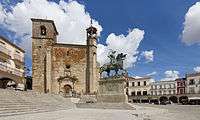 Plaza Mayor
Plaza Mayor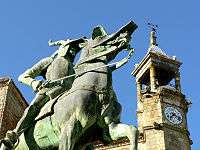 Equestrian statue of Francisco Pizarro
Equestrian statue of Francisco Pizarro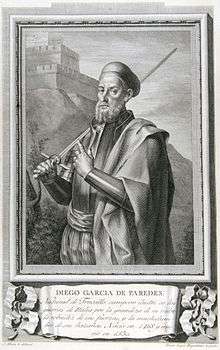
Geography
Climate
Trujillo has a hot-summer Mediterranean climate, type Csa,[2] in the modified Köppen classification.[3]
| Climate data for Trujillo (data for 1961–2001) | |||||||||||||
|---|---|---|---|---|---|---|---|---|---|---|---|---|---|
| Month | Jan | Feb | Mar | Apr | May | Jun | Jul | Aug | Sep | Oct | Nov | Dec | Year |
| Daily mean °F | 45 | 47.7 | 52.7 | 56.5 | 63.9 | 72.7 | 79.7 | 79.2 | 72.5 | 61.9 | 51.8 | 45.7 | 60.78 |
| Average precipitation inches | 2.673 | 2.772 | 2.012 | 2.386 | 2.024 | 1.299 | 0.268 | 0.378 | 1.563 | 2.543 | 3.398 | 3.213 | 24.529 |
| Daily mean °C | 7.2 | 8.7 | 11.5 | 13.6 | 17.7 | 22.6 | 26.5 | 26.2 | 22.5 | 16.6 | 11.0 | 7.6 | 15.98 |
| Average precipitation mm | 67.9 | 70.4 | 51.1 | 60.6 | 51.4 | 33.0 | 6.8 | 9.6 | 39.7 | 64.6 | 86.3 | 81.6 | 623 |
| Source: Ministerio de Agricultura, Alimentación y Medio Ambiente. Datos de precipitación y de temperatura para el periodo 1961-2001 en Trujillo.[4] | |||||||||||||
Monuments
Trujillo has a rich heritage. Among the most important monuments are the Castle (Alcazaba), the church of Santiago, the church of Santa María la Mayor, the church of San Francisco, the Church of San Martín, the Plaza Mayor, and renaissance palaces such as the palace of the Marquis of the Conquest, the palace of the Orellana-Pizarro family, the palace of the Duques de San Carlos, Marquesado de Piedras Albas, the house of the strong Altamirano, Palace Chaves (Luis Chaves Old), and of course the walled old town.
The Palacio de Piedras Albas was built circa 1530 by Don Pedro Suárez de Toledo, formerly owned by the Orellana Toledo family, the Marqueses de Orellana and later by the Marqueses de San Juan de Piedras Albas.[5]
It has several museums: Museum of Coria (Javier Salas Foundation), Pizzaro's House, Enrique Elías Museum (local designer),Museum of Cheese and Wine.


Events
The Chiviri
The culmination of Holy Week is celebrated on Easter Sunday (declared an event of regional interest). The town square is full of people dressed in local costumes. They sing, dance, eat and drink to the beat of Chíviri. The following day, Easter Monday, is a holiday in the city and locals have the custom of going to the countryside for picnics.
National Cheese Fair
On 1 May, the National Cheese Fair takes place, which is the most important cheese competition in Spain. The Plaza Mayor becomes a huge fair where it is possible to taste cheeses from around Spain. This festival draws a large crowd, with organizers reporting that approximately 100,000 people attend on a yearly basis. [6]
Festivities in honour of Virgen de la Victoria
They take place at the end of August or in early September. During the festival the Virgen de la Victoria (Our Lady of Victory) is moved from her normal place in the chapel of the Castle to the church of San Martín, in the Plaza Mayor, where the religious events are celebrated. In addition, there are puppets (The Adventures of Peneque el Valiente (Peneque the brave) with Miguel Pino), capeas and the Festival of Music, Dance and Theatre in the Castle. Also a local teenager is elected as "Queen of the festivities" and she has her own entourage.
Twin Cities
Cities Twin with Trujillo are:
-
 Almagro, Spain.
Almagro, Spain. -
 Batalha, Portugal.
Batalha, Portugal. -
 Castegnato, Italy.
Castegnato, Italy. -
 Santa Fe de Antioquia, Colombia.
Santa Fe de Antioquia, Colombia. -
 Piura, Peru.
Piura, Peru. -
 Trujillo, Peru.
Trujillo, Peru. -
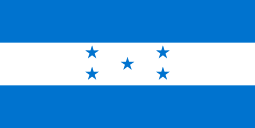 Trujillo, Honduras.
Trujillo, Honduras.
Gallery
- Francisco Pizarro statue
 La Conquista Palace
La Conquista Palace- Home-Museum of Francisco Pizarro
- The Castle
- Old church besides the Castle
- The Plaza Mayor at night
 The Plaza Mayor during the Chíviri.
The Plaza Mayor during the Chíviri._-_RI-53-0000034_-_WLM.jpg) Conjunto Urbano de la Ciudad de Trujillo
Conjunto Urbano de la Ciudad de Trujillo
References
- ↑ http://www.tripadvisor.co.uk/Hotels-g562640-Trujillo_Province_of_Caceres_Extremadura-Hotels.html
- ↑ Critchfield H.J. (1983). University of Idaho, ed. "Criteria for classification of major climatic types in modified Köppen system". General Climatology (4 ed.). Prentice Hall. Archived from the original on 30 September 2009. Accessed 29 November 2012.
- ↑ "Atlas climático ibérico" (PDF). Agencia Estatal de Meteorología.
- ↑ Ministerio de Agricultura, Alimentación y Medio Ambiente. (ed.). "Programa SIGA. Promedios climáticos en la estación 3465 de Trujillo".
- ↑ "Palacio de Piedras Albas". Knight Frank.
- ↑ http://www.feriadelquesotrujillo.es/la-feria.html
External links
| Wikimedia Commons has media related to Trujillo (Spain). |
Tourist information
- Map
- Leisure
- Trujillo cuisine, sights and transport
- National Cheese Fair
- Elaboración y comercialización del queso cacereño—More information about the history of the National Cheese Fair (In Spanish)
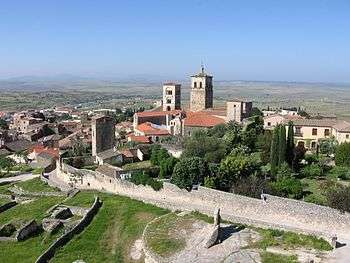
.svg.png)